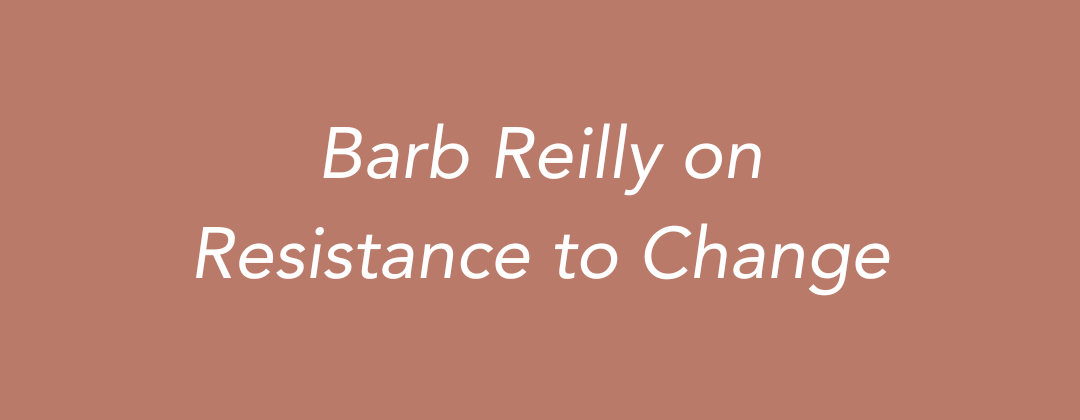

Human beings naturally resist change. When I used to teach graduate students, I would tell them, “Take out your syllabus. There’s going to be a change.” Then, I would just watch their reactions. After a moment, I would stop and say, “We’re not going to talk about the change right now. We’re going to talk about how that made you feel.”
The students would respond with frustration, worry, or even anger. They would say, “I’m afraid the change won’t be good for me. The syllabus is a contract. It has set dates. I don’t want you to change any of these dates.” Simply mentioning a change triggered an immediate emotional response, and this happens in the workplace too. People become comfortable in what they know, how they do things, and the stability of their routines. But businesses must constantly adapt—there will always be new software, new structures, new leaders, new technologies. While people may love the status quo, the world we live in doesn’t allow for stagnation. That’s why organizations must prepare and support their people through change rather than simply hoping for the best.
One major reason people resist change is comfort with the way things are. Another is fear of the unknown. The moment people hear that a change is coming, their minds start racing: “What if this affects my job security? What if my role changes? What if I have to be in the office more? What if my work processes completely shift?” The uncertainty creates anxiety, whether the fears are real or imagined. That fear is compounded if employees don’t trust leadership. If leaders have broken promises before, failed to communicate transparently, or made changes that harmed employees in the past, then any new announcement of change will be met with even greater skepticism. Organizations that fail to recognize this and instead take a “let’s see how this goes” approach will struggle. The organizations that succeed are those that plan for change intentionally.
When leaders implement change, I always ask them: is this change driven by vision, or is it driven by pain? Some companies, facing declining revenue, are forced to change or risk collapse. In those cases, employees often recognize the need, making it easier to communicate why the change is necessary. But change isn’t always a response to hardship. Sometimes, companies that are thriving implement change because they have a vision for growth. In those cases, leaders need employees to trust their direction, which is more challenging. A company facing hardship can say, “If we don’t change, we won’t survive.” A company pursuing a vision must convince employees to buy into a future they can’t yet see. That’s why leaders must approach change with intention, not assumption.
The two most important factors in leading change successfully are communication and participation. Leaders must be clear, transparent, and consistent in explaining the “why” behind the change. Are they providing enough information to reduce uncertainty? Are they addressing employee concerns? Communication has to be part of the plan – who is responsible for it, how often it happens, and what information is shared. I worked with an organization that sent out a weekly change report, keeping employees updated on progress. One week, they considered skipping the report because nothing significant had happened. But when we discussed it, we realized that employees expected that report every Friday at 9 a.m. Without it, they would start speculating, messaging each other, and creating unnecessary worry. So, they sent a simple update: “Not much happened this week. Here’s why. Here’s what’s coming next week. Have a great Friday.” That small action maintained transparency and prevented unnecessary distractions. The communication plan is just as critical as the change plan itself.
Participation is just as important. Employees should be involved before, during, and after a change. Seeking their input, engaging them in decision-making, and designating change champions in different departments can help ease transitions. These champions, given additional context and information, can act as trusted messengers within their teams. Large-scale changes won’t allow every employee to be directly involved, but ensuring representation across the organization makes a difference. Beyond that, most change plans require training and support. If employees need to adopt new technology, they need time to learn it. If customer interactions are changing, they need clear guidance. Change doesn’t just happen – it has to be reinforced with training, support, and leadership modeling the way.
Breaking change into smaller, more manageable steps also makes a significant impact. Consider any major transition – moving to a new home, for example. You don’t pack up everything in one day; you declutter, organize, pack in stages, and then execute the move. Organizations can do the same. Instead of launching a massive shift all at once, can they pilot it in one department? Can they test and adjust before rolling it out at scale? Smaller, incremental steps reduce resistance and create opportunities for feedback. Another often-overlooked strategy is highlighting success stories. When employees see colleagues adapting successfully, it reinforces that the change is manageable and beneficial. Recognizing and rewarding adaptability builds momentum, creating visible proof that the change is working.
Ultimately, successful change requires thoughtful communication, meaningful participation, and a recognition that resistance is natural. Leaders must be intentional in how they introduce, manage, and support change – not just assume that people will embrace it.
Are there any misconceptions about resistance to change that you’ve encountered?
Whenever I encounter a leader and they say “Oh, everyone’s going to love this change. We don’t have to communicate much about it. We don’t really need a change plan.” I love it. I’ll do something really quick with them. I’ll tell them to fold their arms across their chest. And then I’ll tell them to reverse their arms. “What does that feel like?” And the leader will say, “It’s weird, it’s uncomfortable. I don’t like it.”
Then I’ll ask them to imagine that they have to work all day like that. “It would be distracting. I wouldn’t enjoy it. I’d be frustrated. I’d be going to you saying, why do I have to do this? I don’t want to do this. I want to go back to the old way.”
That’s how people feel about change. People rarely say “Change? Awesome, tell me more.” There are folks out there that do like change, but the vast majority of people are going to have some concerns and some frustrations. I know people who’ve left organizations because they’re not interested in learning the next new thing. There’s some people who take a different path and exit an organization when change is so constant and continual; they exit and do something different.
So I think the biggest misconception would be leaders who think this isn’t a big deal. That we don’t need to have communication or that people are all going to love the change. That’s just not true.
How can leaders build a workforce that is resilient to change?
If organizations are constantly changing – and they are – how do we build a workforce that is more open and ready for change? One way is by fostering resilience. Strengthening resilience in the background acts as a booster shot for change, enabling employees to be their best selves and more willing to adapt to challenges.
We know that resilience is shaped by several factors, one of which is optimism. Do employees have an optimistic view of what they can control and improve? Are they operating with a growth mindset – one that embraces effort and persistence as essential to development?
Emotional resilience also plays a crucial role. Helping employees manage stress, regulate their emotions, and practice self-compassion allows them to navigate difficult situations more effectively. When people acknowledge their feelings and take care of themselves during stressful times, they build the foundation needed to embrace change.
So, how do we create a workplace where employees are naturally more open to change? A strong path forward is investing in personal resilience.
Any final words for our readers?
If I had to leave one final thought – and I know I’ve touched on this already – it would be to think of change as a process. Change is systemic; it involves people, departments, systems, and the organization as a whole. No component can be overlooked. Too often, we focus on the technological side of change and forget its personal impact. That’s the part that tends to get lost. I encourage leaders to take a more holistic view, ensuring their plans and processes account for both the technological and systemic aspects of change – and the people. Because all too often, it’s the people we forget.

